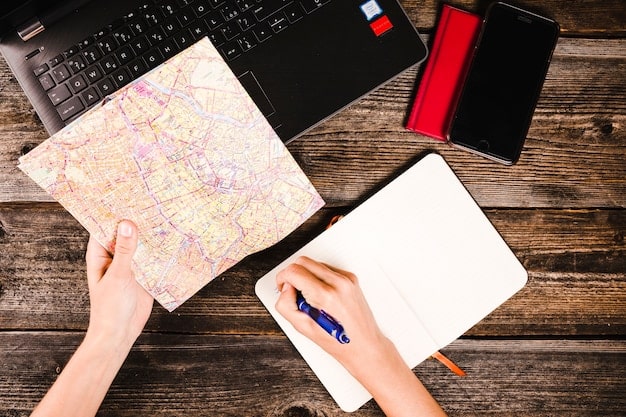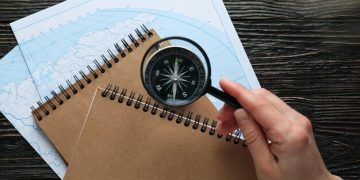Master Travel Itinerary Design in 2 Weeks

Becoming a travel planning pro involves mastering the art of designing expert itineraries, a skill achievable in just two weeks through structured learning of logistics, destination research, budgeting, and optimization techniques.
In a world where travel is more accessible than ever, the ability to craft truly unforgettable journeys often separates a good trip from an extraordinary one. If you’ve ever dreamt of transforming your passion for exploration into a valuable skill, or even a potential career, then learning to master the intricacies of itinerary design is your next great adventure. This guide will walk you through how to Become a Travel Planning Pro: Learn to Design Itineraries Like an Expert in Just 2 Weeks, equipping you with the knowledge and tools to create seamless, enriching, and impeccably organized travel experiences.
The Foundation: Understanding Your Traveler and Destination
Before any routes are drawn or hotels booked, the bedrock of any successful itinerary lies in a deep understanding of who is traveling and where they are going. This initial phase is less about logistics and more about empathy and thorough research, setting the stage for a truly personalized and effective travel plan.
Effective itinerary design begins with profiling the traveler. Are they solo adventurers, a family with young children, a couple seeking romance, or a group of friends looking for adventure? Each demographic has distinct needs, preferences, and limitations that must be addressed from the outset. Understanding preferred travel styles, activity levels, dietary restrictions, and accessibility requirements is paramount to crafting a suitable plan.
Deep Dive into Traveler Profiles
Identifying the primary traveler’s motivations and expectations is equally crucial. Some travelers prioritize relaxation, while others crave adventure or cultural immersion. Detailed conversations or comprehensive questionnaires can unveil these nuances, allowing you to tailor the experience to their specific desires rather than relying on generic templates.
- Identify primary motivations: Relaxation, adventure, culture, food, family fun.
- Assess travel pace preference: Fast-paced, moderate, leisurely.
- Note any special needs: Accessibility, dietary restrictions, medical considerations.
Once the traveler profile is clear, the focus shifts to the destination. Researching a destination goes beyond popular tourist attractions. It involves delving into local customs, climate patterns, peak and off-peak seasons, political stability, and essential cultural etiquettes. This comprehensive understanding ensures a richer, safer, and more respectful travel experience, allowing for authentic interactions and informed decisions.
Comprehensive Destination Research
Leveraging official tourism boards, reputable travel blogs, forums, and academic resources can provide invaluable insights. Pay attention to lesser-known local gems, unique events happening during the travel period, and practical information like local transportation options and currency exchange rates. This meticulous research prevents common pitfalls and uncovers hidden opportunities.
- Consult official tourism websites and government advisories.
- Read reviews and forums for practical tips and local insights.
- Research local transportation, currency, and emergency services.
By thoroughly understanding both the traveler and the destination, you lay a solid foundation for an itinerary that is not just a schedule, but a carefully curated experience designed to fulfill specific desires and navigate potential challenges with grace.
Week 1: Mastering the Essentials of Logistics and Research
The first week of your journey to becoming a travel planning pro is dedicated to equipping you with the fundamental skills for research and logistical organization. This phase is about understanding how to gather information efficiently and how to structure the core components of any trip.
Effective travel planning starts with robust research. This isn’t just browsing travel blogs; it involves cross-referencing information, assessing credibility, and extracting actionable data. Learn to identify reliable sources such as official tourism sites, government travel advisories, and reputable news organizations. Develop a system for organizing your findings, whether it’s through digital tools like Notion or physical notebooks, ensuring easy access to critical details throughout the planning process.
Day 1-2: Destination Deep Dive and Interest Mapping
Begin by selecting a hypothetical (or real) destination and immerse yourself in its culture, geography, and attractions. Utilize online mapping tools to visualize distances and logical groupings of activities. For instance, if planning a trip to Rome, identify key historical sites and their proximity to one another. Simultaneously, create a list of the traveler’s interests (e.g., history, food, art, nature) and map these interests to specific attractions or experiences in the chosen destination.
This early mapping helps create thematic days or groupings of activities, ensuring a flow that minimizes travel time and maximizes enjoyment. Think about how a history enthusiast might spend a day focused solely on ancient Roman ruins, while a food lover might dedicate another to culinary tours and local markets.
Day 3-4: Transportation and Accommodation Fundamentals
Next, dive into the world of transportation. Research various options for reaching and moving within your destination – flights, trains, rental cars, public transport, or even walking. Understand the pros and cons of each, considering cost, efficiency, and traveler comfort. Simultaneously, explore accommodation options. This involves not just finding places to stay, but understanding different types of lodging (hotels, hostels, Airbnb, resorts) and how to evaluate them based on location, amenities, reviews, and budget.
- Compare flight routes and airlines for cost and convenience.
- Investigate local public transport networks (buses, subways).
- Research various accommodation types and their suitability for different travelers.
Practicing with real-world scenarios, such as finding the most efficient way to travel from London to Edinburgh or securing a family-friendly hotel in Orlando, will solidify your understanding. Pay close attention to booking windows and cancellation policies, which are critical elements of flexible travel planning.
Day 5-7: Budgeting and Activity Curation
The final part of Week 1 focuses on financial planning and activity selection. Develop a comprehensive budget template that accounts for all potential expenses: flights, accommodation, food, activities, transportation within the destination, visas, travel insurance, and an emergency fund. Learning to estimate these costs accurately is a hallmark of expert planning.
Simultaneously, begin curating activities that align with the traveler’s interests and the overall budget. Don’t just list popular attractions; seek out unique experiences, local workshops, or lesser-known sights that could enrich the trip. Consider creating a balance between planned activities and free time, allowing for spontaneity and relaxation.
By the end of Week 1, you should be proficient in gathering reliable information, laying out basic logistical frameworks, and creating a preliminary budget. These foundational skills are essential before moving into the more intricate aspects of itinerary design.
Week 2: Advanced Itinerary Design and Optimization Techniques
With a solid foundation in logistics and research from Week 1, your second week will elevate your skills to a professional level, focusing on the art of sequencing, time management, and adding those expert touches that transform a good itinerary into an exceptional one.
This week is about connecting the dots and refining your plan. You’ll learn how to create a logical flow for each day, factoring in travel time between locations, rest periods, and unexpected delays. The goal is to build an itinerary that is ambitious yet realistic, preventing traveler burnout while maximizing the experience. This stage involves a blend of practical scheduling and creative thinking to ensure every moment counts.

Day 8-10: Daily Sequencing and Time Blocking
Start by breaking down the trip into individual days. For each day, map out the activities, considering opening and closing times of attractions, popularity (to avoid long queues), and geographical proximity. Implement time blocking, assigning specific time slots for activities, meals, and travel. Remember to factor in buffer time for transitions, unexpected delays, or simply enjoying a moment. For example, when planning a visit to a museum, include travel to and from, the estimated time inside, and a short break afterward.
- Allocate realistic time for each activity, including travel.
- Group nearby attractions together to minimize transit.
- Include ‘flex time’ for spontaneity or unforeseen events.
Critically evaluate the pace of each day. Is it too packed, leading to exhaustion, or too sparse, leaving travelers bored? Adjust as necessary to maintain a balanced rhythm throughout the trip. Think about logical progression: don’t schedule a strenuous hike right before a formal dinner, for instance.
Day 11-12: Contingency Planning and Resource Integration
No trip goes exactly as planned, which is why expert itinerary design includes robust contingency planning. Identify potential risks – bad weather, strikes, unexpected closures, personal illness – and formulate alternative plans. This might involve listing indoor activities for rainy days or alternative transportation routes. Simultaneously, integrate all necessary resources directly into the itinerary: booking confirmations, contact numbers for accommodations and activities, emergency contacts, visa information, and any health protocols.
Modern tools like Google Maps for offline access, translation apps, and digital copies of important documents can be seamlessly integrated. This meticulous preparation provides peace of mind and equips travelers to handle minor disruptions with ease.
Day 13-14: Personalization, Refinement, and Final Review
The final days are dedicated to adding the expert touch. Review the entire itinerary from the traveler’s perspective. Are there opportunities for unique, personalized experiences? Can you recommend a local restaurant that perfectly matches their tastes, or a hidden viewpoint they wouldn’t find on their own? This level of detail shows genuine care and expertise.
- Add personalized recommendations such as local eateries or unique shops.
- Review all bookings and confirmations for accuracy.
- Create a digital and print version of the itinerary.
Refine the presentation, making it clear, easy to read, and visually appealing. Consider using a clear layout, color-coding, or digital tools that allow for interactive elements. Finally, conduct a rigorous final review. Check all dates, times, addresses, and contact information. Ensure the budget is realistic and all necessary preparations (visa, insurance, vaccinations) are addressed. By the end of Week 2, you’ll have a perfectly crafted itinerary, ready for an unforgettable journey.
Budgeting Like a Pro: From Estimation to Real-Time Management
An expert travel itinerary isn’t just about where to go and what to do; it’s crucially about managing the financial aspects with foresight and precision. Budgeting effectively is a skill that distinguishes a casual planner from a true professional, allowing for not just cost control, but also strategic allocation of resources to maximize value and experience.
The first step in professional budgeting is moving beyond simple guesswork. Before any bookings are made, create a detailed expenditure breakdown. This involves estimating costs for major categories: transportation (flights, trains, local transit), accommodation (per night, per person), food (meals, snacks, drinks), activities (tours, entrance fees, special experiences), shopping, and miscellaneous items (souvenirs, tips). Don’t forget pre-trip expenses like visa applications, travel insurance, and necessary gear. Researching average costs in the destination is vital for accuracy.
Categorizing Expenses for Clarity
Developing a systematic approach to categorizing expenses helps in tracking and control. Break down ‘food’ into ‘restaurants,’ ‘groceries,’ and ‘snacks.’ ‘Transportation’ can be divided into ‘inter-city’ and ‘intra-city.’ This granularity allows for more precise tracking and easier adjustments during the trip. Utilizing a spreadsheet or a dedicated budgeting app can provide a clear visual overview of allocated versus spent amounts.
- Create a detailed spreadsheet with major expense categories.
- Break down categories into sub-categories (e.g., food: fine dining, casual, groceries).
- Allocate a “contingency fund” for unexpected expenses (10-15% of total budget).
Beyond initial estimation, real-time budget management during the trip is crucial. This involves tracking spending daily and adjusting future expenditures as needed. For instance, if a particularly expensive meal was enjoyed, compensating with more budget-friendly options the next day can keep the overall budget on track. This dynamic approach ensures financial stability throughout the journey without compromising essential experiences.
Tools for Smart Budgeting
Leverage modern tools and habits to maintain financial control. Currency conversion apps, expense tracking apps that link to bank accounts, or even a simple daily ledger can empower travelers to stay within their financial limits. Encourage the use of a combination of cash and credit cards, understanding exchange rates and foreign transaction fees. Providing tips on how to save money while traveling, such as cooking some meals or opting for free attractions, also adds value to your planning.
By treating the budget as a living document that evolves with the trip, you empower travelers to make informed financial decisions, ensuring their journey is as fiscally sound as it is memorable.
Crafting Unique Experiences: Beyond the Tourist Traps
While iconic landmarks draw visitors, a truly expert itinerary transcends the obvious, weaving in unique, authentic experiences that provide deeper cultural immersion and lasting memories. This involves moving beyond syndicated tours and exploring local life, hidden gems, and off-the-beaten-path adventures.
The key to crafting unique experiences lies in proactive research and a willingness to explore lesser-known aspects of a destination. Tap into local blogs, community forums, niche travel groups, and even academic resources to uncover activities that don’t appear in mainstream guidebooks. This could be anything from attending a local festival, participating in a cooking class with a local family, or visiting a neighborhood known for its artisanal crafts rather than its popular attractions.
Leveraging Local Insights
Connecting with locals, even virtually before the trip, can provide invaluable insider knowledge. Online platforms allow you to interact with residents who can recommend their favorite haunts, tell you about upcoming events, or even offer unique experiences like home-cooked meals or guided tours of their neighborhood. This direct interaction often leads to the most authentic and memorable encounters.
- Search for local community events or street art tours.
- Identify unique workshops or classes related to local crafts/cuisine.
- Explore historical or natural sites that are not heavily advertised.
Consider the traveler’s specific interests and how they can be uniquely fulfilled in the destination. For an art lover, this might involve visiting independent galleries or artist studios. For a nature enthusiast, it could be a guided hike through a lesser-known national park trail. Tailoring these unique elements makes the itinerary deeply personal and far more rewarding than a generic checklist of sights.
Integration of these unique experiences should be seamless. They shouldn’t feel like add-ons but rather natural components of the daily flow. Balance them with popular attractions to provide a holistic view of the destination. The joy of planning an expert itinerary comes from the thrill of discovery, both for the planner and ultimately, for the traveler.

Dealing with the Unexpected: Contingency Planning and Flexibility
Even the most meticulously planned itinerary encounters unforeseen circumstances. An expert travel planner understands that perfection isn’t the goal; resilience and adaptability are. Mastering contingency planning and building flexibility into your itineraries are crucial skills that ensure a smooth journey, even when things deviate from the original script.
The anticipation of potential issues starts during the research phase. For each day or major activity, consider “what if” scenarios. What if it rains? What if a museum is closed? What if public transport strikes? By identifying these potential roadblocks, you can proactively brainstorm alternative activities, routes, or solutions. This isn’t about fostering anxiety, but about empowering travelers with ready-made alternatives.
Building in Buffer Time and Options
A key aspect of flexibility is incorporating buffer time. Don’t pack every minute of the day. Allow for extra time between activities, for leisurely meals, or for simply exploring a charming alleyway you stumble upon. This prevents rushing and provides breathing room for unexpected delays. Additionally, offer alternative options for activities. If a popular attraction has long queues, suggest a nearby alternative or a different time to visit.
- Include a “Plan B” for major activities (e.g., indoor option for outdoor activities).
- Research alternative transportation routes or methods.
- Keep a list of “filler” activities for unexpected free time.
Beyond daily flexibility, consider the overall trip structure. Booking accommodations with flexible cancellation policies, having travel insurance that covers delays or cancellations, and understanding visa requirements in advance are critical. For international travel, always advise on having copies of important documents, both physical and digital, and knowing the location of the nearest embassy or consulate.
Providing critical contact information, such as local emergency numbers, the helpline for airlines or hotels, and your own contact details as the planner, instills confidence. An expert planner doesn’t just create a schedule; they create a safety net, ensuring that even when the unexpected happens, the journey remains enjoyable and manageable.
Tools and Resources for the Modern Travel Planner
In today’s digital age, becoming a travel planning pro is significantly aided by a wealth of online tools and resources. Leveraging these effectively can streamline your research, optimize your itineraries, and enhance the overall travel experience for your clients or yourself. Familiarity with the right technology is as crucial as understanding destinations.
At the core of modern travel planning are mapping and navigation tools. Google Maps, for instance, provides not only directions but also information on public transport, walking times, business hours, and user reviews. Integrating specific points of interest directly into custom maps allows travelers to visualize their daily routes and understand distances between attractions. Other apps like Maps.me offer offline map capabilities, invaluable in areas with limited internet access.
Digital Planning Platforms and Apps
A variety of digital platforms are designed specifically for itinerary creation. Tools like TripIt, Wanderlog, and Roadtrippers allow you to consolidate flight, hotel, and activity bookings into a single, organized itinerary. Many of these platforms offer collaborative features, enabling shared planning with fellow travelers. They often provide real-time updates on flight statuses, gate changes, and weather forecasts, adding another layer of professionalism to your planning.
- Utilize aggregation tools like TripIt or Wanderlog for centralized information.
- Explore flight and accommodation comparison sites for best deals.
- Download translation and currency converter apps for on-the-go assistance.
Beyond mapping and aggregation, critical resources include flight and accommodation comparison websites (e.g., Skyscanner, Kayak, Booking.com, Airbnb). These allow for efficient price comparison and booking management. Don’t overlook specialized tools like SeatGuru for flight seat reviews or resources like Numbeo for cost of living comparisons, which can inform budget planning.
Finally, stay updated with official government travel advisories (e.g., U.S. Department of State for U.S. citizens) and health organizations (e.g., CDC) for real-time safety and health information. Subscribing to travel industry news outlets and forums can also keep you informed about emerging trends, new destinations, and best practices in travel planning. By embracing these tools, you transform the complex task of itinerary design into an efficient and sophisticated process.
| Key Point | Brief Description |
|---|---|
| 🗺️ Foundational Research | Understand traveler needs and conduct deep destination research. |
| 🗓️ Logistics & Itinerary Sequencing | Master daily planning, time blocking, and efficient transitions. |
| 💰 Expert Budgeting | From detailed estimation to real-time expense management. |
| ✨ Unique Experiences | Incorporate local insights and off-the-beaten-path adventures. |
Frequently Asked Questions About Travel Planning
While true mastery takes years, you can achieve a high level of proficiency and become capable of designing effective, nuanced itineraries within two weeks of dedicated, structured learning. This rapid advancement is possible by focusing on core principles and iterative practice, applying lessons to real or hypothetical trips.
The most crucial elements include a deep understanding of the traveler’s preferences, seamless logistical flow for daily activities, a realistic budget with contingency funds, unique local experiences beyond typical tourist sites, and robust flexibility for unforeseen circumstances. Balancing these ensures a well-rounded and enjoyable journey.
Flexibility is paramount. No trip goes exactly as planned, so building in buffer time, alternative activities for bad weather, and having a realistic outlook on potential changes ensures a smooth trip even when disruptions occur. Contingency planning minimizes stress and maximizes enjoyment, making it a hallmark of expert design.
Essential digital tools include comprehensive mapping applications (e.g., Google Maps), itinerary aggregation platforms (e.g., TripIt, Wanderlog), flight and accommodation comparison websites, and specialized apps for currency conversion or language translation. These tools streamline research, booking, and on-the-go adjustments, enhancing efficiency significantly.
Yes, designing custom travel itineraries can absolutely be a viable career path. Many independent travel advisors and planning services specialize in crafting bespoke journeys for clients, leveraging their expertise to provide personalized and unique experiences that traditional travel agencies might not offer. Demand for tailored experiences is growing.
Conclusion
Embarking on the journey to Become a Travel Planning Pro: Learn to Design Itineraries Like an Expert in Just 2 Weeks is an achievable and rewarding endeavor. By systematically delving into traveler profiling, rigorous destination research, logical sequencing, meticulous budgeting, and embracing the art of contingency planning, you can transform your passion for travel into a highly sought-after skill. The true mark of an expert planner lies not just in flawless organization, but in the ability to craft compelling narratives for each trip, integrating unique local experiences and anticipating real-world challenges. Armed with the right tools, knowledge, and a commitment to continuous learning, you’re now poised to create extraordinary travel adventures, whether for yourself or for others, making every journey truly unforgettable.





